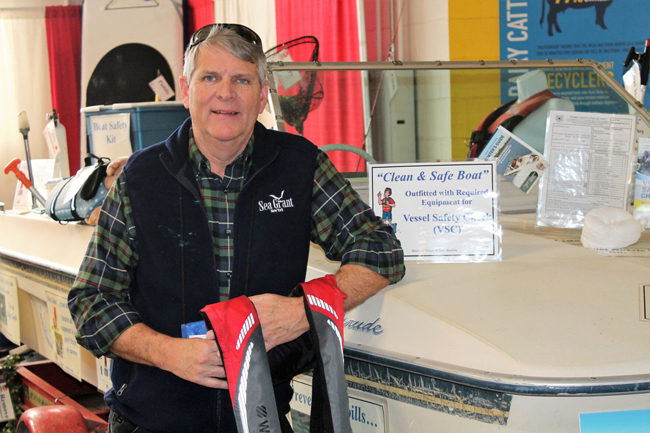
New York Sea Grant Coastal Recreation Specialist David G. White II holds an inflatable life vest at a boating information exhibit at an annual Central New York Boat Show in Syracuse. For many years, Mr. White and a couple of associates would demonstrate the vests at a 4-feet-deep pool brought in for the show. He recalled that one year, an enhanced water safety education program was held for first responders at the boat show. “Two weeks later, one of the fire departments used some of the information they got there to save two people on the Oswego River,” Mr. White said. Credit: Courtesy of NY Sea Grant
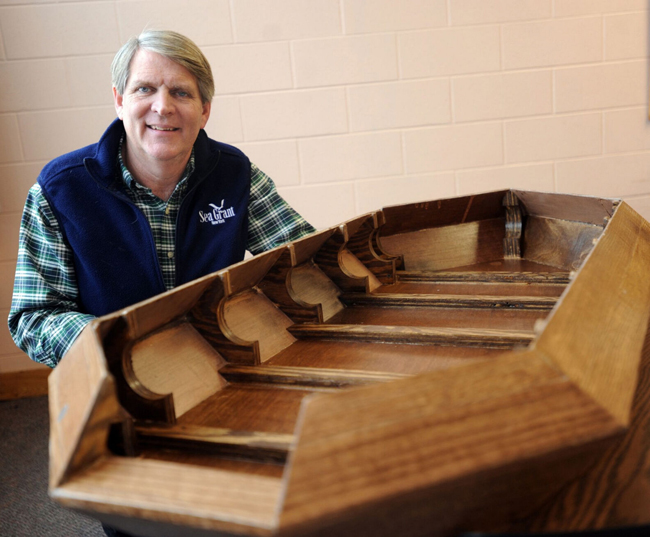
In 2015, New York Sea Grant Coastal Recreation Specialist David G. White II curated the exhibit, “Great Shipwrecks of New York’s Great Lakes,” which debuted at the New York State Fair. He then took the exhibit on the road. Here, Mr. White poses with a mini replica of the turtle ship Radeau, built in 1758 and sunk the same year in Lake Champlain. Credit: Watertown Daily Times
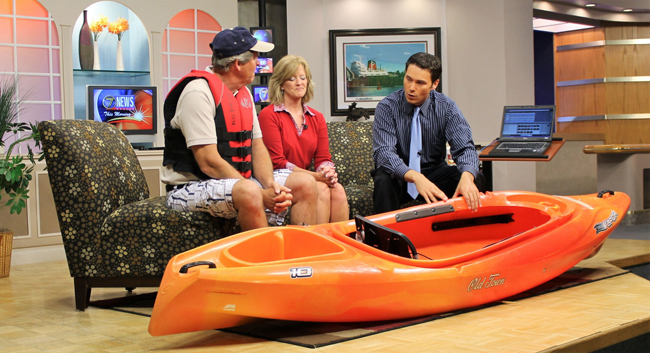
New York Sea Grant Coastal Recreation Specialist David G. White II often worked with the media in his 38-year career to get the word out. Here, Mr. White, left, shares information on safe boating and the “Wear it!” life jacket program at WWNY-7 studios with Beth Hall and Jeffery L. Cole. Credit: Courtesy of Sea Grant
— By Chris Brock, NNY 360 Powered by Watertown Daily Times and Northern New York Newspapers
Watertown, NY, November 12, 2022 — From the wrecks of ships, to the guts of fish, David G. White II has treasured educating people about our coastal areas and waterways for nearly 40 years.
In a few days, after 38 years, he’ll retire from his job as New York Sea Grant coastal recreation and tourism specialist, and he’ll look upon our shorelines and waterways a bit differently. But it won’t be with any less love or admiration for the region.
“Going through this process to retire, it’s been fascinating to me that one of the first questions everybody asks is, ‘Where am I moving to?’” Mr. White said, with many people wondering about retreats in southern states.
“As a tourism and recreation person, I’ve been fascinated by that,” he said over coffee earlier this month at Dunkin’ on Washington Street. “I’m not moving anywhere. Sitting here, within a two-hour drive, I can be at one of the best Great Lakes and one of the greatest rivers in the world. There is nothing comparable to the St. Lawrence River. We have great high peaks. And if I drive an hour south, I can get on a canal and go anywhere in the world, connected by water. If you give me a state, or a place I can do all of that, I’ll move. It’s here. Many of us just take it for granted.”
It’s that wonder for the area, knowledge about it and how he shares that knowledge that is appreciated by those who have worked with him in the past 38 years.
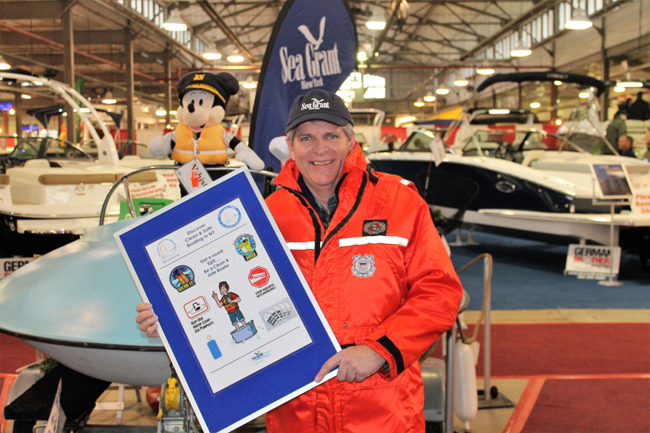
New York Sea Grant Coastal Recreation Specialist David G. White II, wearing a flotation suit, holds a poster with some of the “Discover Clean & Safe Boating” messages he’s shared throughout his 38-year career. Credit: Courtesy of NY Sea Grant
“We have a strong organization and Dave’s contribution to the group was invaluable,” said Andrew R. Wickham, manager of the Central New York Boat Show, organized by the Boating Industries Association of Upstate New York. “He was very brilliant with what he did, but he was very practical in bringing it down to the level where the common boater would understand what he was talking about. And he always did it with humor. That was all part of how Dave was so successful. He was able to keep interest because he was entertaining as well as informative.”
Mr. White credits the others he has worked with for his success.
“I haven’t done anything by myself,” he said. “I’ve realized that as I look back over 38 years of educational programming. Everything I’ve done has been with other people. I might be the face of it, or the mouth of it. I might be in front of the room or behind the scenes, but I’m doing it with a whole cadre of people.”
Sea Grant, established in 1966, is a national network of 34 university-based programs and the Sea Grant Collection at the National Oceanic and Atmospheric Administration Central Library. New York Sea Grant, established in 1971, is one of the largest of the state Sea Grant programs. It’s a cooperative program of SUNY and Cornell University, with administrative offices at Stony Brook University, extension administration at Cornell University in Ithaca, and extension specialists in Stony Brook, Kingston, Brooklyn, Elmsford, Buffalo, Newark and Oswego. Mr. White is based at the Sea Grant office at SUNY Oswego, where staff addresses issues ranging from aquatic invasive species to sustainable recreational and commercial fisheries.
Among Mr. White’s notable programming:
• Developed annual in-water demonstrations at the Central NY Boat Show and Empire Farm Days.
• Created Great NY State Fair exhibits on maritime history and boating safety, with marinas, boat dealers, U.S. Coast Guard/auxiliary, Power Squadron, scout troops, 2014-2019.
• Requested to educate American Samoa National Marine Sanctuary personnel on clean, safe and environmentally-friendly boating, 2016.
• Created Discover Clean and Safe Boating program, 2008.
• Produced “Discover Better Boating” YouTube series with Boating Industries Association of Upstate New York.
• Long-time adviser to Great Lakes Seaway Trail National Scenic Byway development program.
• In 2012, invited to a White House briefing on Great Lakes issues.
• Associate director of the Great Lakes Research Consortium.
Key BOCES program
Mr. White grew up in Elmira Heights, Chemung County in the state’s Southern Tier.
“When I was in high school, I wasn’t the most brilliant student in the world,” he said. “My family was heavy into hunting, fishing. So, I had a real interest in natural resources and conservation.”
He further honed those skills through a Board of Cooperative Educational Services program that focused on those two issues.
“I had to argue with my parents to go to BOCES, because back then, it had a stigma to it,” Mr. White said. “They had a fabulous agriculture program with a land lab and forestry stuff. I really enjoyed that.”
He graduated with a Regents diploma with BOCES certification and then went to SUNY Morrisville to study natural resources. Following that two-year program, he was accepted to Cornell University, Ithaca, for which he credited a buddy who was director of admissions.
“My wife, then girlfriend, went to Ithaca College, and every time I visited her, I would stop in his office and harass him,” Mr. White said. “And I swear to God, the only reason he accepted me was to get me out of his office.”
While at Cornell, he said a mentor he met at SUNY Morrisville urged him to go to graduate school and promised him a job afterward. So he went to SUNY College of Environmental Science and Forestry in Syracuse, where he earned a master’s degree in resource management.
In 1982 at SUNY Morrisville, Mr. White was appointed director of alumni programming. But after two years, he sought something more “hands-on” as a career.
“I realized I didn’t want my career to be as a college administrator, and that was the direction I was headed,” he said.
He noticed a vacancy in the Oswego Sea Grant office.
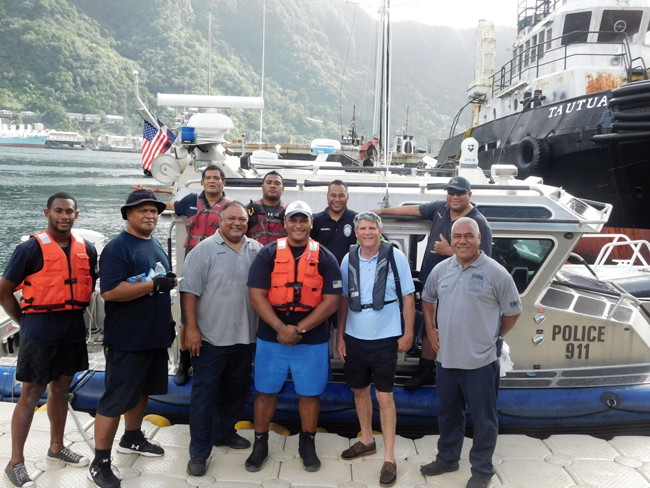
In 2016, New York Sea Grant Coastal Recreation Specialist David G. White II, front, second from right, was invited to American Samoa to teach clean and safe boating practices to a dive response team, with which he poses with here, and to local National Marine Sanctuary personnel as well as EMS crews. Courtesy of NOAA
“I applied for it, got the job and low and behold, 38 years later, here I am,” he said. “It’s been a fabulous career. I’ve always looked at myself as an educator and a conservationist very focused on ethics and good, solid use and maintenance of our resources.”
Explaining the why
Mr. White said it’s been rewarding to see people become better informed about aquatic-related issues as he educated and advised.
“To my colleagues’ credit at Sea Grant and the people we’ve been able to work with, whether it be the charter fishing captains, marina operators, boaters — they all became, a better citizenry,” he said. “They started asking really good questions and a part of the process.”
He recalled going to a state Department of Environmental Conservation program where, he said, an official turned to him and asked, “How do these people know to ask such good questions?”
“A lot of folks within agencies and others were never trained to work with people,” Mr. White said. “They weren’t trained to work with boats and other things. They were asking about these things very seriously. They weren’t complaining about maybe a new regulation. It was, ‘Why? Give me the ‘why’ behind it.’”
For example, Mr. White educated boaters on the importance of using bilge socks. The items are designed to be placed in the bilge to soak up gas or oil before it can be discharged outside the boat during bilge pumping, fueling or accidentally.
“If you help them understand the reason why, they’re going to go, ‘That makes great sense. Why haven’t we done it before?’” Mr. White said. “Don’t belittle them. That’s the fabulous part of the educational process: watching people grow and ask exceptional questions.”
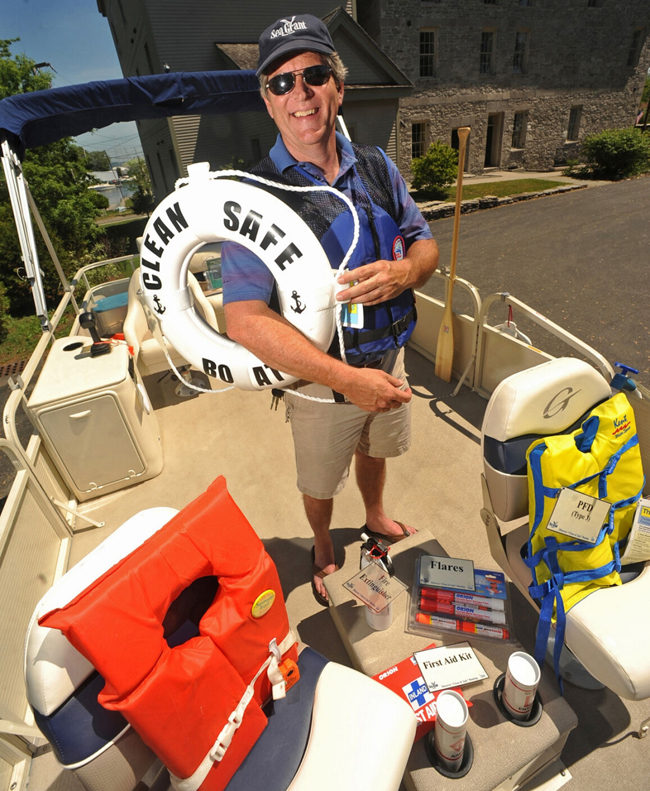
In this 2010 photo, New York Sea Grant Coastal Recreation Specialist David G. White II stands in a “Clean, Safe Boat” at the Seaway Discovery Center in Sackets Harbor. Credit: Watertown Daily Times
Water levels are one of those top issues of concern and for questioning. There were lots of questions during the implementation of Plan 2014. The International Joint Commission adopted the plan in 2016 to update its more than 50-year-old regulations in Plan 1958-DD, which failed to take natural occurrences such as changes in temperature and ice cover into account and adversely affected wetland ecosystems.
“I was on the recreational boating and tourism subgroup working on that,” Mr. White said. “And it was fascinating to work with folks to have them better understand it.”
He added, “That’s education. I don’t set policy. I don’t have an opinion on whether Plan 2014 was good, bad or indifferent. But you need to be able to understand it in order to argue one way or another.”
The plan, which took more than 16 years and $20 million to develop, was predicted to also help garner financial gains for hydropower generation and recreational activity.
But the first year of the plan, which went into effect Jan. 1, 2017, faced widespread criticism when that year coincided with widespread flooding caused by increased precipitation. The region also saw widespread flooding in 2019. Governments and politicians called for the repeal of Plan 2014. Meanwhile, the flooding has led to several shoreline resiliency projects.
“It became very difficult,” Mr. White said of those flood-filled years. “You’re trying to explain this plan to people, and they’re just trying to survive. I think many people have come back around. They have a better understanding of it, a better understanding of shoreline processes, how lakes and river work — flow and littoral drift — all those kinds of things that back in the ’80s and ’90s we weren’t thinking a lot about. That’s what I’ve enjoyed seeing: watching people grow and appreciate it more and, ‘How can I protect my property as a landowner, but protect it in a way that’s good for me, my neighbors and the environment?’”
Sanctuary and shipwrecks
For the past few years, the public has had a chance to get educated on the proposed Lake Ontario National Marine Sanctuary consisting of waters offshore of Wayne, Cayuga, Oswego and Jefferson counties. Sea Grant says the area includes 43 known shipwrecks, dating to the late 1700s, and one submerged aircraft, with the potential to add more shipwrecks and submerged aircraft. A U.S. National Marine Sanctuary is managed by NOAA. The proposal does not include restrictions to shipping. NOAA would exclude the ports and harbors of Oswego, Pultneyville, Little Sodus, Great Sodus and Port Ontario from the boundary of the sanctuary. NOAA is considering two possible boundaries for the proposed sanctuary. The Alternative 1 boundary encompasses a portion of eastern Lake Ontario and a segment of the Thousand Islands region of the St. Lawrence River, while Alternative 2 only encompasses the same portion of eastern Lake Ontario. A decision is expected next year.
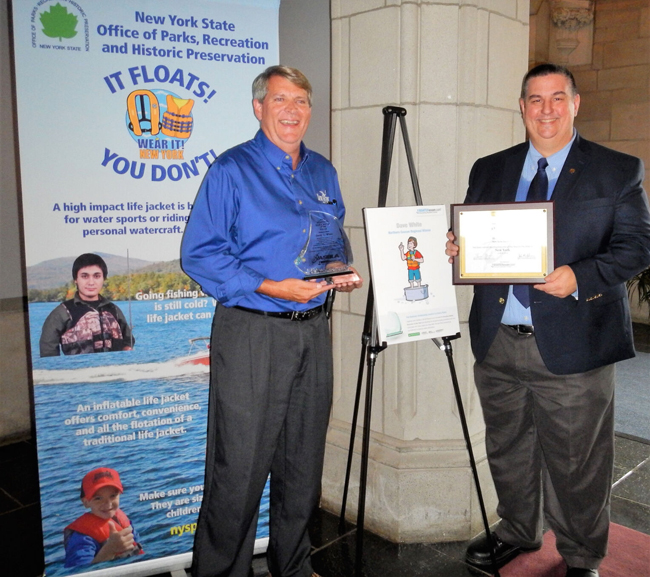
New York Sea Grant Coastal Recreation Specialist David G. White II, left, receives the 2015 Northern States Boating Educator of the Year Award from the National Association of State Boating Law Administrators from Larry Migliozzi of the New York State Parks Marine Services Bureau. Mr. White was also the 2015 New York State Boating Educator of the Year, selected by the NYS Office of Parks, Recreation and Historic Preservation. Credit: Courtesy of NYS Parks
NOAA’s network of national marine sanctuaries totals 15. The National Marine Sanctuary of American Samoa, which Mr. White was invited to in 2016, is located in the cradle of Polynesia’s oldest culture. The sanctuary protects extensive coral reefs and Mr. White was invited because of his knowledge on clean and safe boating practices.
“Their sanctuary is one of the most pristine choral reefs in the world,” Mr. White said. Pollution from boats is an obvious concern, and Mr. White shared information on how to keep petroleum products from going from the boat overboard by the use of such things as bilge socks and fuel bibs. Mr. White, sanctuary and Sea Grant officials also hosted a dive safety training drill for officials, which included emergency responders.
The multi-county approach to the proposed Lake Ontario sanctuary delights Mr. White. “It was the first time I saw four counties coming together holistically to say, ‘We’re really interested in working together.’”
But it remains to be seen whether the cooperation will lead to a sanctuary.
“We’ll have to wait and see, but the momentum that’s there — that’s going to carry forward, whether it’s designated or not,” Mr. White said. “It brings a whole new opportunity to communities.”
One of those opportunities would be history-related, Mr. White said. He recalled the first diving program Sea Grant hosted, and the late Rosemary S. Nesbitt, a SUNY Oswego Distinguished Teaching professor and founder of Oswego’s H. Lee White Marine Museum, attended and showed great interest.
“Everybody was like, ‘Rosemary doesn’t dive,’” Mr. White recalled. “But she was like, ‘I don’t like to get my hair wet in the shower. But I so want to learn about what you find with these ship wrecks, these time capsules. I can share that in the museum because there are a lot of people like me who don’t dive.’”
Mr. White added, “New York has some of the most historic wrecks, fully intact, in the world. New York was the gateway to the rest of the country. We were it. We have some of the most historical military, commercial and commerce wrecks in the world right here in New York.”
‘A mind change’
Mr. White sees great potential related to diving if the sanctuary is approved, with those divers becoming a clientele for area businesses. For example, he said charter captains, who now take out fishing clients, would have a new customer base.
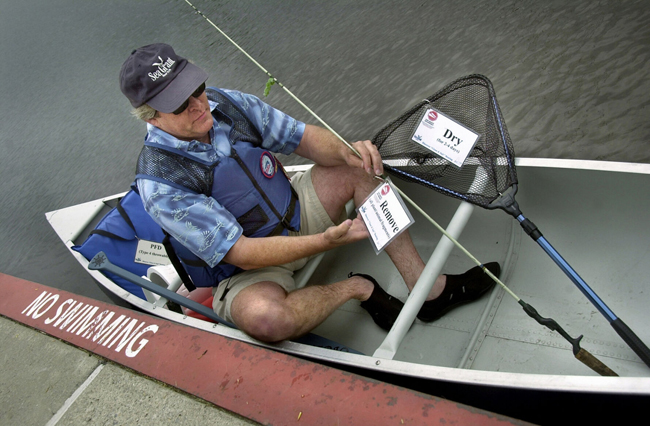
New York Sea Grant Coastal Recreation Specialist David G. White II demonstrates correct procedures and safe boating measures for canoers and kayakers in 2011 at the Sackets Harbor boat launch. Credit: Watertown Daily Times
“That’s a mind change,” Mr. White said. “A lot of them may feel, ‘It’s fish, so I became a charter captain.’ You are a captain who can take people for hire. It doesn’t matter what you take them to do. It just has to be safe, authorized, etcetera.”
He foresees a day when a local charter captain takes fishing clients out in the morning, returns to port, and after a retrofit and taking along a first mate/dive master, takes out diving clients in the afternoon.
Divers also need a place to clean and dry their gear, he said. “And you don’t want it on your shower curtain rod.”
He compared such education to salmon and trout fishing, especially in Oswego County, and how its popularity skyrocketed, but leaving behind a trail of entrails in the early days. It was realized that fish cleaning stations were needed. Mr. White helped to design the units and also educated on the composting of entrails.
“That’s where the education side came in,” he said. “Businesses were getting it out of their businesses, getting it better controlled, contained and everybody had a better understanding of ‘Why can’t I just do this along the shore?’ That’s not good for the environment in any way, shape or form. Fish cleaning stations became the norm, and people thought that was great.”
Happy trails
When Mr. White began his job at Sea Grant, he said the Seaway Trail, designated in 1978, went through four counties. Now, the 454-mile stretch trail borders Great Lakes Erie and Ontario as well as the St. Lawrence River.
“I was part of extending it all the way throughout all 10 New York Great Lake counties,” Mr. White said. He credited people like the late Charles Krupke, early president of the Great Lakes Seaway Trail and the late Teresa Mitchell, longtime president and CEO of the trail, for its success.
“Just great people who saw the big picture,” he said. “And what a great opportunity it was for people to go from point A to point B and at each point, learn. The Seaway Trail was one of the preeminent and early scenic byways in the country and one of the first in New York. Now we have many. People looked at us as a model.”
On Friday, many new trails will open up for Mr. White after he punches in for his last day at Sea Grant. But he won’t be wandering too far from his home on Bernhard’s Bay, a hamlet in Oswego County on the north shore of Oneida Lake. He lives there with his wife, Sylvia.
“She and I have been together since high school,” Mr. White said. “I was a junior, she was a sophomore and we’ve been together ever since. I just stayed with her because I figured no one else was going to take me.”
They have two daughters. Shawna, the oldest, who works in the horse industry in Kentucky. Marissa lives in North Carolina, where she works with people with disabilities.
Mr. White is looking forward to exploring New York, especially with Sylvia, in a more freewheeling fashion, and on weekdays, when they now have time and popular spots aren’t as busy.
“I’m a fan of waterfalls, beaches, boating and all of that,” Mr. White said. “And there are some great places I’ve yet to visit in New York. I haven’t had time. I’ll throw a kayak on top of the Jeep. And now, I also have an inflatable kayak and an inflatable paddle board. They fit in a backpack. I can pull into any parking lot where there’s water.”
From there, it will be an educated assessment, not a professional determination, about where he’ll decide to go next.
More Info: New York Sea Grant
New York Sea Grant (NYSG), a cooperative program of Cornell University
and the State University of New York (SUNY), is one of 34 university-based
programs under the National Oceanic and Atmospheric Administration’s
National Sea Grant College Program.
Since 1971, NYSG has represented a statewide network of integrated
research, education and extension services promoting coastal community
economic vitality, environmental sustainability and citizen awareness
and understanding about the State’s marine and Great Lakes resources.
Through NYSG’s efforts, the combined talents of university scientists
and extension specialists help develop and transfer science-based
information to many coastal user groups—businesses and industries,
federal, state and local government decision-makers and agency managers,
educators, the media and the interested public.
The program maintains Great Lakes offices at Cornell University, SUNY
Buffalo, SUNY Oswego and the Wayne County Cooperative Extension office
in Newark. In the State's marine waters, NYSG has offices at Stony Brook
University in Long Island, Brooklyn College and Cornell Cooperative
Extension in NYC and Kingston in the Hudson Valley.
For updates on Sea Grant activities: www.nyseagrant.org has RSS, Facebook, Twitter, Instagram, and YouTube links. NYSG offers a free e-list sign up via www.nyseagrant.org/nycoastlines for its flagship publication, NY Coastlines/Currents, which is published quarterly.